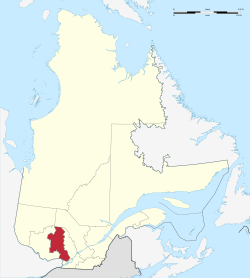| Laurentides | |
|---|---|
| Administrative region | |
 | |
| Coordinates: 46°26′N 74°59′W / 46.433°N 74.983°W / 46.433; -74.983 | |
| Country | |
| Province | |
| Regional County Municipalities (RCM) and Equivalent Territories (ET) | 7 RCM, 1 ET |
| Government | |
| • Conseil des préfets et des élus de la région des Laurentides (Regional conference of elected officers) | Ramez Ayoub (President) |
| Area | |
| • Land | 20,779.19 km (8,022.89 sq mi) |
| Population | |
| • Total | 631 719 |
| • Density | 28.4/km (74/sq mi) |
| Demonym | Laurentien(ne) |
| Time zone | UTC-5 (EST) |
| • Summer (DST) | UTC-4 (EDT) |
| Postal code | J |
| Area code | 450, 579 |
| Website | www.laurentides .gouv.qc.ca |
The Laurentides (French: [lɔʁɑ̃tid], Canadian French: [lɔʁɑ̃t͡sid] ) is a region of Quebec. While it is often called the Laurentians in English, the region includes only part of the Laurentian Mountains. It has a total land area of 20,779.19 km (8,022.89 sq mi) and its population was 589,400 inhabitants as of the 2016 Census.
The area was historically occupied by the Algonquin First Nation. English Canadians began settling in the 1700s in towns like Arundel and Harrington and St. Columban and Clyde, today's La Conception. French Canadians began settlement in the first half of the 19th century, establishing an agricultural presence throughout the valleys. During the 20th century, the area also became a popular tourist destination, based on a cottage and lake culture in the summer, and a downhill and cross-country ski culture in the winter. Ski resorts include Saint-Sauveur and Mont Tremblant.
The Laurentides offer a weekend escape for Montrealers and tourists from New England to Ontario, and with the building of a major highway through the area in the 1970s (Autoroute 15), the area has experienced much growth. Its largest city is Saint-Jérôme, in its extreme southeast, with a 2011 census population of 68,456 inhabitants.
Administrative divisions
Regional county municipalities
| Regional County Municipality (RCM) | Population 2016 Canadian Census |
Land Area | Density (pop. per km) |
Seat of RCM |
|---|---|---|---|---|
| Antoine-Labelle | 35,243 | 14,976.99 km (5,782.65 sq mi) | 2.4 | Mont-Laurier |
| Argenteuil | 32,389 | 1,252.97 km (483.77 sq mi) | 25.8 | Lachute |
| Deux-Montagnes | 98,203 | 243.42 km (93.98 sq mi) | 403.4 | Saint-Eustache |
| La Rivière-du-Nord | 128,170 | 451.02 km (174.14 sq mi) | 284.2 | Saint-Jérôme |
| Les Laurentides | 45,902 | 2,479.05 km (957.17 sq mi) | 18.5 | Mont-Blanc |
| Les Pays-d'en-Haut | 41,877 | 683.46 km (263.89 sq mi) | 61.3 | Sainte-Adèle |
| Mirabel (Equivalent Territory) | 50,513 | 485.07 km (187.29 sq mi) | 104.1 | Mirabel |
| Thérèse-De Blainville | 157,103 | 207.20 km (80.00 sq mi) | 758.2 | Sainte-Thérèse |
Indian Reserve
Major communities
- Saint-Colomban
- Saint-Eustache
- Saint-Jérôme
- Sainte-Anne-des-Plaines
- Sainte-Marthe-sur-le-Lac
- Sainte-Sophie
- Sainte-Thérèse
See also
References
- ^ "Census Profile, 2016 Census: Laurentides [Economic region], Quebec". Statistics Canada. Retrieved November 24, 2019.
- "La région des Laurentides, ainsi que ses MRC et TE". Profils des régions et des MRC (in French). Quebec: Institut de la statistique du Québec. 2011. Archived from the original on 9 February 2012. Retrieved 26 June 2012.
- "Population and Dwelling Count Highlight Tables, 2016 Census". Statistics Canada. Retrieved November 26, 2019.
- (Mirabel is both a City and a territory equivalent to a regional county municipality)
External links
- Portail régional des Laurentides Portail régional des Laurentides
- Tourisme Laurentides Official website — Site Officiel
- CRÉ
- Événements culturels dans les Laurentides
| Administrative divisions of Quebec | |
|---|---|
| Subdivisions | |
| Communities | |
| Major cities | |
| Regions | |
| Portal:Canada | |
This Quebec location article is a stub. You can help Misplaced Pages by expanding it. |